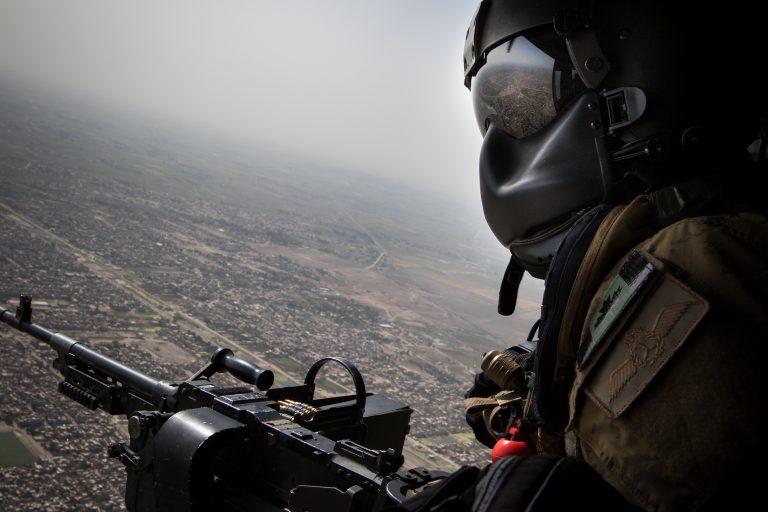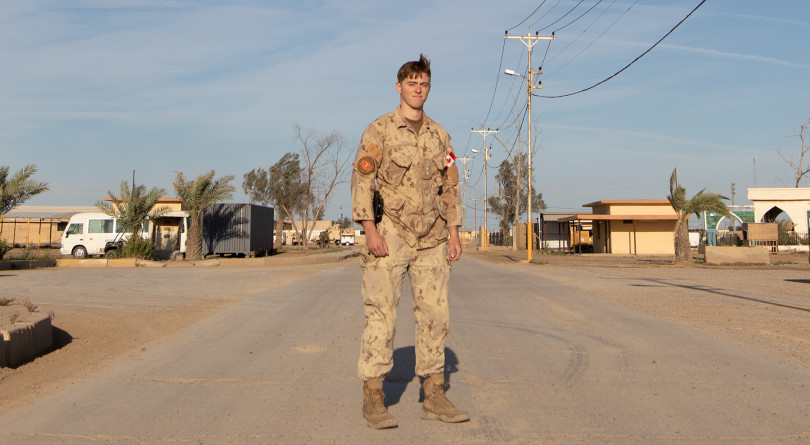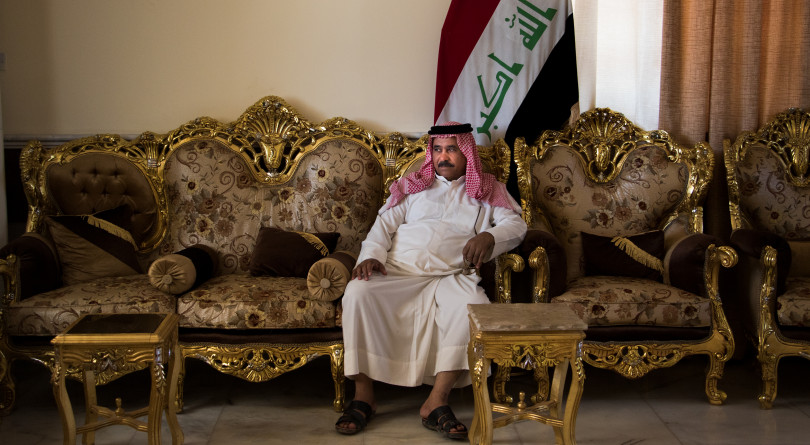Can Canadian soldiers stop the next Iraq insurgency?
The race is on to prepare Iraq for a whole new deadly insurgency led by ISIS fighters, and Canadian soldiers are in the middle of it

A Canadian gunner surveys the Iraqi countryside: a fine line between training and combat (Photograph by Adnan R. Khan)
Share
Latifiya has never fully accepted the end of Saddam Hussein’s rule. The predominantly Sunni town 40 km south of Baghdad was a key launching ground for the insurgency that began in 2004 and descended into a civil war. It was part of the ostentatiously named Triangle of Death that included the towns of Mahmudiya to the north and Yusufiya to the west.
In 2004, the insurgents here were not yet part of the growing al-Qaeda in Iraq network. They called themselves the Honourable Resistance, Saddam loyalists who lost their power and influence after the collapse of the regime following the U.S. invasion and the chaos it triggered. But in time, Latifiya would become a hotbed of al-Qaeda support, and during the expansion of ISIS across Iraq and Syria it would again shelter its fighters. Mahmudiya was first controlled by the Shia Mahdi Army, led by the anti-American cleric Muqtada al-Sadr, but eventually it also fell to al-Qaeda.
During my first visit here in 2004, I was captured by members of the Honourable Resistance, held for hours, questioned, threatened with death and, luckily, eventually released. In late April, both villages are again buzzing with activity, though now it’s not militancy that rules the streets but the routine bustle of everyday life. The rat-a-tat-tat of hammers hitting nails as the towns rebuild has replaced the gunfire that once terrified its residents. Still, the wounds from those years of hatred have yet to fully heal.
READ MORE: The last days of ISIS
Karim Kadhim remembers those days well. The 42-year-old principal at Ali al Wardi School recalls how, during the Saddam era, Sunni and Shia in Mahmudiya lived together in peace. But the U.S. invasion in 2003, he says, tore apart the social fabric. Shia in the town turned to the Mahdi Army for protection, while Sunnis turned to al-Qaeda.
Neighbours fought each other. “Terrorism is like a virus,” he says. “One person calls another person a terrorist. Then that person calls the other person a terrorist. Eventually, everyone is a terrorist to someone.”
At the graduation ceremony of his sixth graders, Kadhim points out that those same people who once pointed fingers at each other and called each other terrorists are now sitting together drinking tea again. He nods to an old man in a black and white kaffiyeh. “That is Sheikh Hikmat Kaven,” he says. “He supported al-Qaeda at that time.”
Kaven turns to Kadhim with a wry smile: “When they first came they said they were fighting in the name of God, and we believed them,” he says in his defence. “They said they were here to fight the Americans, so we helped them. But then they started fighting us, so we helped the Americans fight them.”
ISIS, Kaven adds, was a different kind of beast. Its brutality has been a wake-up call. “We were stupid back then, but now we’ve learned our lesson. These people do not care about us. They want power and they will kill whoever stands against them.”
The peace, however, remains precarious. The Shia militias, known as the Hashd al Shaabi, some with loyalties to Iran, now control Mahmudiya, as the Mahdi Army once did. And a terrifying but familiar force is lurking again: ISIS sleeper cells roam the fields around the town, with some sheikhs in the area rumoured to be working with them.
***
It wasn’t so long ago that U.S. President Donald Trump announced the “total defeat” of ISIS. Its death was touted as a major victory over the Salafi-jihadist project, and the end of the caliphate would take the steam out of the ideology behind it, proponents of this view boasted.
Only it hasn’t. The caliphate is gone but the hardened fighters are not. Its networks remain intact, its financing secure and its global appeal still startlingly effective. The Sri Lanka bombings—one of the worst terror attacks since 9/11—offered the terrifying evidence. Even its leader, Abu Bakr al Baghdadi, once thought either dead or gravely injured, appeared in a video at the end of April looking plump and in charge.
Thousands of fighters who fled Syria after the fall of the caliphate have now fanned out throughout Syria and Iraq—like those once again patrolling the Triangle of Death—where sectarian divides, corruption and foreign meddling have created an ideal setting for an ISIS resurgence.
It’s in this dangerous void that Canada is now operating in Iraq, the lead country in a new NATO training mission made up of 470 troops from 22 nations tasked with preparing Iraqi security forces for a difficult fight.
Just over 200 soldiers, mostly from Quebec, have joined the more than 650 Canadian service members, including Special Forces, already operating in the country, making Iraq Canada’s signature foreign military intervention, with a commitment running into 2021.
The goal, commanders on the ground say, is straightforward: ensure the lasting defeat of ISIS and help raise an Iraqi army that is self-sufficient and capable of defending Iraq against any future threats. But the recent history of Iraq—and of ISIS—suggests a hard road ahead. And time is running short.

When Lt. Lukas Kaemmerer received word he would be deployed to Iraq, his first thoughts were consumed by the excitement of his first overseas deployment. The 24-year-old Mississauga, Ont., native had always dreamed of joining the military. After two years in university, he took advantage of the Regular Officer Training Program to pay for his degree in civil engineering and was posted to the 5 Combat Engineer Regiment in Valcartier, Que.
At the time, ISIS was at its height, controlling a huge swath of territory in Iraq and Syria. Canadian Special Forces were embedded with Kurdish Peshmerga forces in Iraq’s north and preparing for the siege of Mosul, the ISIS caliphate’s crown jewel.
From the safety of his base in Quebec, Kaemmerer found it difficult to wrap his head around ISIS’s brutality. What he understood was what his training in explosive ordnance disposal had taught him: the tactics they used were deadly. Defeating them would mean people like him—combat engineers—would have to put their lives on the line.
During the Mosul offensive, ISIS did not disappoint. Booby traps and improvised explosive devices became the scourge of Iraqi counterterrorism units on the front lines. Thousands lost their lives, or if they were lucky, only a limb or two.
In the end, ISIS was defeated and, as its caliphate crumbled, Kaemmerer came to believe the group was gone for good. Its last stand in eastern Syria felt like an ending, he says—the condition of the ragged fighters limping out of the battle zone a just fate for the crimes they had committed.
But when he arrived in Iraq in February, Kaemmerer discovered a very different reality. “I didn’t know the extent to which ISIS was still present in Iraq,” he says. “I thought they’d been completely wiped out. I got here and heard they might be coming back as an insurgency, that they’ve come back into Iraq from Syria.”
Based out of the sprawling Taji military installation less than 30 km north of Baghdad, Kaemmerer has had some time to rethink what his mission to Iraq means. In the beginning, he saw it merely as a training mission to help the Iraqi Military Engineering School modernize its course curriculum. Now, with an insurgency looming, his role feels more critical. Kaemmerer heads up a team of Canadians deployed with the NATO Mission in Iraq, tasked with helping the Iraqi army improve its capabilities. His specialty is route clearance—an innocuous-sounding name for a job that, in the fight against an enemy like ISIS, means exposing oneself to its deadliest tactic: roadside bombs.
The Iraqi soldiers he has worked with, he says, have ample experience when it comes to improvised explosive devices. “As individuals, they’re fine,” he says. “But the way they do it is by habit. What we’re trying to show them is that if they have better procedures and work together as a team, they will stand a better chance of saving lives—not just their own lives, but civilian lives.”
***
In its current form, ISIS has been active for only five or six years, but its origins stretch back at least to 2004, shortly after the U.S. invasion of Iraq.
At that time, the first signs were emerging of what would evolve into one of the world’s most brutal civil wars. The sectarian hatreds unleashed by the U.S. invasion were still in their infancy, but all the mistakes that led to them had already been made. The original sin, of course, was the invasion itself, predicated on false intelligence and executed with such disregard for a post-war strategy that it seemed almost as if the goal itself was chaos.
First came the looting: as American soldiers watched, Iraqis went to work dismantling Iraq’s precious history and culture. Nothing was spared: works of art disappeared along with priceless relics; Saddam’s palaces were ransacked, government buildings stripped bare. Then came the catastrophic Coalition Provisional Authority, led by Paul Bremer. Under his tutelage, the Iraqi army was disbanded, its soldiers and officers left jobless. Secret military prisons sprouted up around Iraq where Sunni men were herded and tortured. It was here that al-Qaeda in Iraq—what would become ISIS—recruited its most hardened fighters.
READ MORE: How the fight to defeat ISIS sparked a new battle in Iraq
Random attacks and the deaths of a few U.S. soldiers began to unsettle the occupying forces. And with support for the war already precarious back home, orders came down to keep the locals at a distance. By August, the U.S. had retreated behind blast walls and barbed wire. Any hint of goodwill was gone.
In 2014, when ISIS swept through predominantly Sunni Mosul, the poorly trained and largely Shia army collapsed. ISIS fighters, numbering in the hundreds, easily drove out Iraqi soldiers numbering in the thousands.
Maj.-Gen. Dany Fortin, the current commander of the NATO mission, says the Iraqis would like to avoid a repeat.
“There’s a realization at all levels that to defeat ISIS you must invest in the long term,” he says, speaking at his office in Baghdad’s fortified Green Zone. “The Iraqi Ministry of Defence understands that to do this means they have to invest in capabilities, in expertise, to grow their own security institutions so that they are able to withstand the resurgence of violent extremist organizations.”
In shaping the NATO mission, Fortin has employed a distinctly Canadian “whole of government” approach. Teams like Kaemmerer’s engineers will focus on training Iraqis at their combat engineering and explosive ordnance disposal schools so they can take the lead in training the next generation of Iraqi soldiers. The goal is sustainability, so missions like Operation Inherent Resolve—in which an unknown number of Canadian Special Forces are still reportedly embedded with the Iraqi army hunting ISIS sleeper cells—can finally come to an end.
FROM THE ARCHIVES: A whole new war is about to hit Iraq
Other Canadians are working directly with the Iraqi ministries of defence, interior and health to help build institutional capacities so that the whole system can operate efficiently. But the challenges are daunting.
“In many ways now we are in a race to the future,” Brig.-Gen. Colin Keiver, Canada’s top commander with Operation Inherent Resolve, tells me by telephone from the coalition headquarters in Kuwait. “It is about building Iraqi capacity so they are able to deal with an ISIS now trying to establish itself as an insurgency. We’ve seen attacks increase, whether it be improvised explosive devices or small arms.”
Then there are the sectarian divides, which continue to plague Iraq. The fight against ISIS has only deepened those divides after Iraq’s Shia leaders called for the creation of militias to take on the Sunni extremist group. Those militias were key to ISIS’s defeat and have now embedded themselves in the Iraqi security services, refusing to disband.

In Latifiya, Sheikh Modhir al Janabi has a reputation for anti-government sentiment. It was the al Janabi tribe that captured me in 2004, and it remains on the cusp of returning to the insurgency. At his palatial meeting hall, incongruously set amid ragged fields on the outskirts of the village, the sheikh remains openly distrustful of the Iraqi government as well as any foreign presence in Iraq.
He is also an avid conspiracy theorist. Over the course of one hour, he stitches together wild tales of U.S. and Iraqi government support for al-Qaeda. He claims the U.S. created ISIS as an excuse to come back to Iraq and that the U.S. plan all along has been to break the back of Iraqis to take control of the country.
“It’s like the story of the elephant,” he says. “It’s very difficult to train an elephant. So what can you do? You wear black; you dig a hole in the ground. When you trap the elephant, you start to beat him and treat him badly. He will cry, that elephant. Then you leave and return dressed in white. You offer the elephant water; you clean him up and treat him tenderly. Then the elephant will listen to you. This is what the Americans have done in Iraq.”
The Iraqi government receives even less respect. According to al Janabi, it was Nouri al Maliki, the former Iraqi prime minister, who orchestrated a prison break in 2013 in which hundreds of al-Qaeda prisoners were set free, reinforcing ISIS ranks. In fact, the incident was carried out by ISIS itself, part of a strategy Baghdadi announced in 2012 to free its imprisoned fighters.
RELATED: Life amidst the ISIS insurgency
But for al Janabi, being ruled by what he calls an “Iranian proxy” from Baghdad—referring to the feeling among many of Iraq’s Sunnis that the central government favours the Shia majority—is unacceptable. “We brought peace to Latifiya ourselves,” he says, “without the army, without the Americans. But now the army is back. They have these checkpoints again. That’s a problem for us.”
Al Janabi is not entirely off the mark. Iraq’s government, particularly under Maliki, has been criticized for developing close ties to the Iranians and inflaming sectarian tensions. The army has been accused of mistreating Sunnis, though its reputation is beginning to improve, while the Shia militias have developed a penchant for extrajudicial killings and believing all Sunnis are terrorists.
The issue, Brig.-Gen. Keiver says, is front and centre for the coalition. “We’ve seen tension; we’ve seen open conflict frankly between some of the PMFs and the Iraqi security forces,” he says, using another acronym for the militias. “We’ve seen some of the PMFs engage in criminality to support their activities in terms of vehicle checkpoints. It’s a big challenge and it’s one the Iraqi government has absolutely got to wrestle with.”
At the Taji military base, the Shia militias pose a direct threat. Canadian forces, along with their international coalition partners, are housed in what’s known as the Green Zone, protected by their own blast walls and sentries. Outside the Green Zone is the Amber Zone, where the Iraqi military and some Shia militias are based. For the training, Kaemmerer and his team must leave the Green Zone and travel a short distance to the Iraqi Military Engineering School in the Amber Zone.
Members of the force protection team that accompanies them tell me their biggest concern is the Shia militias. “We see them sometimes watching us,” one of the team members says, requesting anonymity. “They take notes on our movements. We’re not sure what they’re up to.”
READ MORE: Why the ISIS threat lives on
The Shia militias are only one of the dangers Canada faces. The NATO mission may be “non-combat” only, according to Maj.-Gen. Fortin, but some of what Canada is doing rides the fine line between passive training support and active combat.
In taking the lead at this initial stage, for instance, Canada has also contributed three Griffon transport helicopters that provide logistical support for Canadian forces as well as other members of the coalition. Two of the helicopters are in the air virtually every day on multiple flights between bases, often travelling low over open terrain where there is risk of an ISIS presence.
Canada also provides a force protection unit in Baghdad that is tasked with escorting civilians and other members of the NATO mission around the city.
“We’re one of the few countries actively involved in doing security in Baghdad,” says Maj. Nicholas George, the commander of the unit. “We’re out on the streets every day, but our relationship with the Iraqi forces is excellent and the intelligence we receive from them gives us a very good understanding of the threats we face.”
Those threats are likely to increase in the coming weeks and months. Baghdad is calm for the time being, but locals say they fear an ISIS insurgency could break out at any moment.
Maj.-Gen. Fortin is adamant that regardless of what happens, Canada’s role in the NATO training mission will not change. “There will be no mission creep,” he says. “Our goal here is to help the Iraqis prepare for any contingency, including the emergence of another extremist group, whether it’s ISIS or the Son of ISIS or whatever they might call themselves.”
That eventuality is a near certainty.
CORRECTION, May 14, 2019: An earlier version of this story used an incorrect given name for Lt. Lukas Kaemmerer. This story has also been updated to include new numbers of Canadian service members in Iraq.
This article appears in print in the June 2019 issue of Maclean’s magazine with the headline, “Back in the Triangle of Death.” Subscribe to the monthly print magazine here.